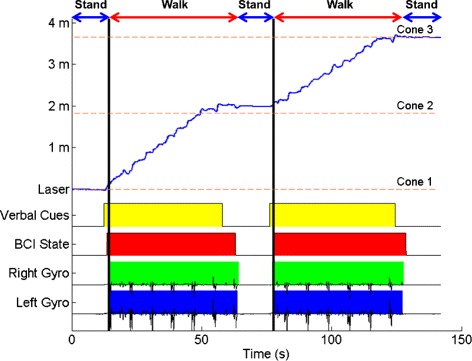Fig. 6.

Representative space-state-time plot. The best overground walking test results (data from the 2 nd test on the 28th visit). The beginning and end of yellow blocks mark the onset of the “Walk” and “Idle” verbal cues, respectively, given by the experimenter. Red blocks represent periods when the BCI system was in the walk state; otherwise, the system is in the idle state. Green and blue blocks represent leg movements recorded by the gyroscopes. The laser signal (blue trace) represents the space-time plot, i.e. the participant’s position within the course as measured by the laser distance meter. Note that there is a delay between the onset of the “Idle” cue and the BCI idle state. This latency includes the time required for the participant’s cognitive processing and EEG to change, as well as the time required for BCI processing. The discrepancy between the onset of the idle state and gyroscope signals is due the fact that transitions from the walk to idle state can be decoded at any time during the pre-programmed 4-s step cycle. For example, if the state transition occurs during an uninterruptible leg swing, the participant will finish the leg swing despite the BCI system being in the idle state (e.g. the first green block). If, on the other hand, the state transition occurs after a leg swing, the leg will be stationary even before the system enters the idle state (e.g. the second green block). Finally, the discrepancy between the gyroscope signals and the distance meter is due to the participant only progressing when the front-wheel walker is advanced, which happens once every 4 s. Hence, all the leg movements prior to walker advancement will be registered by the gyroscope, however, they will not contribute to a position change
